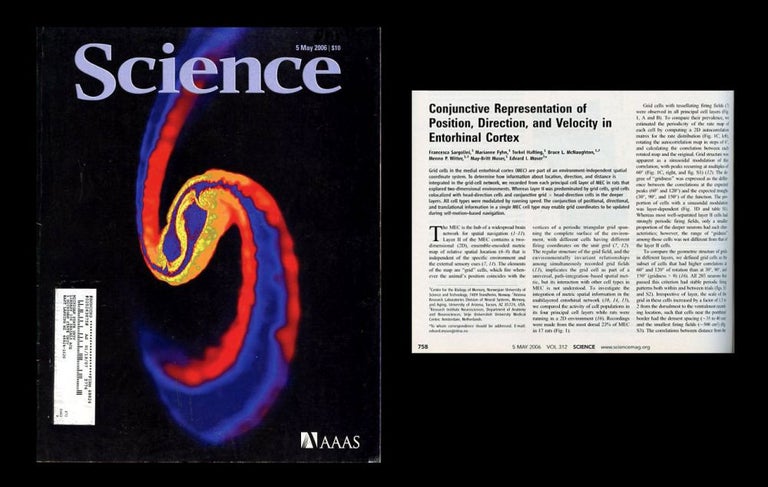Conjunctive Representation of Position, Direction, and Velocity in Entorhinal Cortex in Science 312, No. 5774, 5 May 2006, pp. 758-762
New York: American Association for the Advancement of Science, 2006. 1st Edition. FIRST EDITION of a work that contributed greatly to our understanding of our ‘inner GPS’ -- “where we are, how we know the way from one place to another, and how we store this information in order to immediately find the way when we repeat a path” (Adaes, The Coordinates of a Nobel Prize, 2014). This work builds upon and contributes significantly to the 2005 work of Sargolini’s co-authors who won the Nobel Prize (also in 2005) for their discovery of a key component the brain’s positioning system – ‘grid cells.’
“Grid cells are neurons that fire when a freely moving animal traverses a set of small regions (firing fields) which are roughly equal in size and arranged in a periodic triangular array that covers the entire available environment” (Wikipedia).
Sargolini et al proved that “navigation requires representation of the animal’s orientation relative to fixed landmarks in the external environment” Shepherd, Handbook of Brain Microcircuits, 184). They showed that the brain contains cells that contribute to this process, cells they named ‘head direction cells.’
“Grid cells in the medial entorhinal cortex (MEC) are part of an environment-independent spatial coordinate system. To determine how information about location, direction, and distance is integrated in the grid-cell network, we recorded from each principal cell layer of MEC in rats that explored two-dimensional environments. Whereas layer II was predominated by grid cells, grid cells colocalized with head-direction cells and conjunctive grid x head-direction cells in the deeper layers. All cell types were modulated by running speed. The conjunction of positional, directional, and translational information in a single MEC cell type may enable grid coordinates to be updated during self-motion-based navigation” (Sargolini abstract).
In other words, certain layers of the MEC “contain cells responsive the the animal’s head direction, either in the form of pure head direction tuning or combined head direction and grid-like [conjunctive] tuning” (Derdikman, Space, Time and Memory, 380). Item #482
CONDITION & DETAILS: New York: American Association for the Advancement of Science. 8vo. [2], 645-794. Ex-libris bearing only a very light stamp on the contents page and a mailing label on the front wrap. Original wraps with minor rubbing at the edge tips. Very good condition.
Price: $120.00

